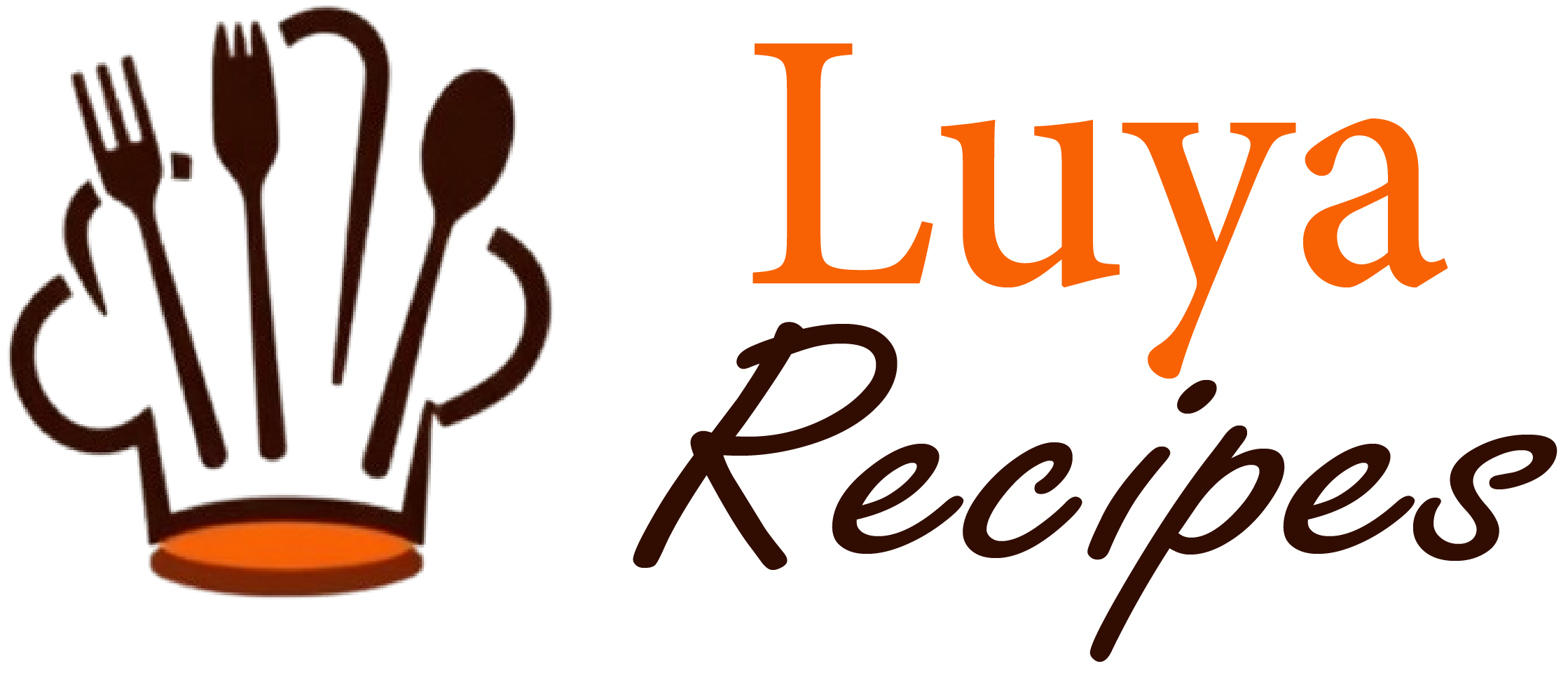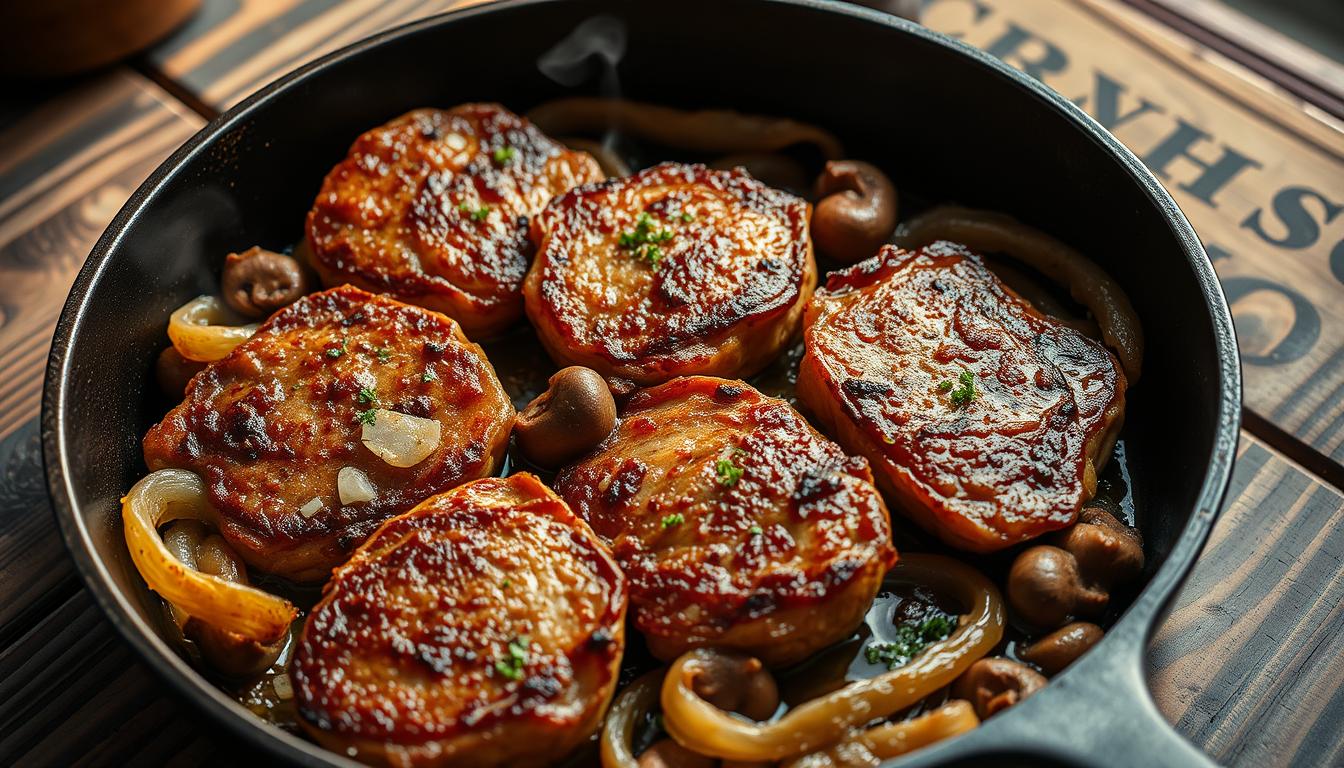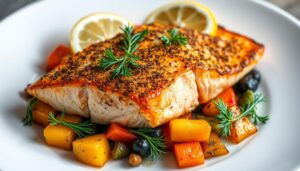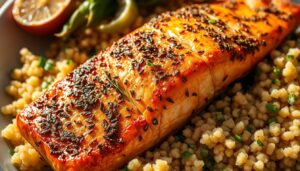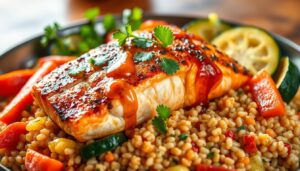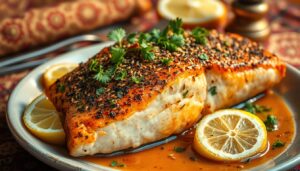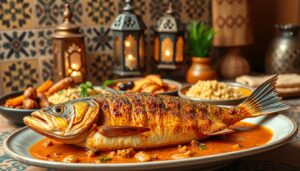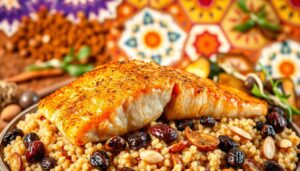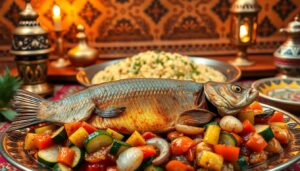Imagine being in the wilderness, surrounded by autumn air. The smell of wild game cooking over an open flame fills the air. Wild game recipes like fried deer meat are more than food. They connect us to nature’s oldest cooking traditions.
Venison has long fascinated hunters and food lovers. It offers a flavor unlike any other meat. Fried deer meat turns lean, wild protein into a tasty dish that honors the hunter’s work.
Start your wild game recipe journey here. We’ll dive into the world of deer meat. You’ll learn about its unique traits and how to fry it perfectly. Discover why fried deer meat is a favorite among outdoor cooking fans.
Table of Contents
Understanding Wild Game Meat Characteristics
Wild game recipes open a new world of flavors. Deer meat is a standout protein with a great nutritional profile and unique taste. It’s different from regular meats.
Wild game, like venison, is a nutritional powerhouse. It has health benefits that make it great for those who care about their diet.
Nutritional Powerhouse of Venison
Comparing venison to other meats shows its nutritional edge:
- It has very little fat (2-3%) compared to beef (15-20%)
- It has more protein per serving
- It’s rich in zinc
- It has about 40% more iron than domesticated meats
Flavor Profile Comparison
Deer meat has a special taste. Wild game recipes show its rich, slightly gamey flavor. This is different from regular meats.
Natural Diet Impact
The deer’s diet affects its meat quality. Wild deer eating various plants have a more complex flavor. This makes venison dishes taste deeper and more nuanced.
Knowing these special traits helps you see venison’s great taste and health benefits.
Essential Preparation Techniques for Deer Meat
Preparing deer meat for your hunting recipes is key to great flavor and texture. Wild game meats are different from regular meats. They need special handling to reach their full potential.
Here are the main steps for preparing venison:
- Trim excess fat and silverskin to reduce gamey flavors
- Allow meat to reach room temperature before cooking
- Use proper aging techniques to enhance tenderness
- Select appropriate marinating methods
Aging venison is crucial for developing rich, complex flavors. Hunters say to keep fresh deer meat at 34-37°F for 7-14 days. This breaks down muscle fibers and makes the meat taste better.
“Proper preparation transforms wild game from tough to tender” – Hunting Cuisine Experts
Venison Preparation Metrics
| Preparation Step | Recommended Time | Purpose |
|---|---|---|
| Room Temperature Rest | 20-30 minutes | Ensures even cooking |
| Meat Aging | 7-14 days | Enhances tenderness |
| Marinating | 3-12 hours | Improves flavor profile |
Learning these preparation techniques will make your hunting recipes stand out. It turns wild venison into a delicious dish.
The Art of Fried Deer Meat
Learning to fry deer meat well takes skill and patience. Your journey to making crispy deer steak begins with understanding how to cook this lean, tasty meat.
Temperature Control Tips
Keeping the temperature right is key when frying deer meat. Aim for 130-135 degrees Fahrenheit for a medium-rare finish. Cooking too hot can make the venison tough and less tender.
- Use a meat thermometer for accurate readings
- Maintain low to moderate heat
- Avoid temperatures above 135 degrees
Proper Oil Selection
Picking the right oil is crucial for a great crispy deer steak. Opt for oils with high smoke points like peanut, canola, or avocado oil. They help achieve a perfect golden-brown crust.
| Oil Type | Smoke Point | Flavor Profile |
|---|---|---|
| Peanut Oil | 450°F | Neutral |
| Canola Oil | 400°F | Light |
| Avocado Oil | 520°F | Mild |
Cooking Time Guidelines
Timing is crucial when frying deer meat. Cooking times depend on the cut’s thickness. Thin cuts take 2-3 minutes per side, while thicker pieces need 3-4 minutes.
Venison is very lean, with only about 3 grams of fat per serving. So, be careful not to dry out the meat. Letting your fried deer meat rest for 5-10 minutes after cooking helps keep it juicy and flavorful.
Best Cuts for Frying Venison
Choosing the right cut of venison is key for tasty crispy deer steak. Not all cuts are the same for frying venison. Knowing the different meat sections and their traits is important.
The most prized cuts for frying include:
- Backstrap (Loin): The most tender cut, perfect for quick frying
- Tenderloin: Extremely soft and ideal for crispy deer steak preparations
- Shoulder cuts: Require tenderizing but can create flavorful venison dishes
When preparing venison for frying, consider these key factors:
- Cut thickness should be around ½ inch for even cooking
- Pound tougher cuts to ¼ inch for tender results
- Trim excess fat and connective tissue before cooking
“The secret to perfect fried venison is choosing the right cut and preparing it with care.” – Wild Game Chef
Nutritional considerations matter too. A typical serving of fried venison contains about 359 calories. It also has 41g of protein. This makes it a great choice for those watching their diet but still want to enjoy tasty meat.
Pro tip: For the most tender results, choose younger deer meat. Avoid cuts from older animals, as they are tougher and need more preparation.
Seasoning and Marinade Options
Turning wild game into delicious southern dishes is all about seasoning and marinades. Venison needs special care to highlight its unique taste.
Traditional Southern Seasonings
Southern cooking has many ways to flavor wild game. Your deer meat will taste amazing with these classic flavors:
- Black pepper and kosher salt base
- Paprika for depth of flavor
- Garlic and onion powder blend
- Cayenne pepper for subtle heat
Marinade Recipes for Tenderizing
Marinades are key to tender deer meat. Acidic ingredients help break down tough fibers.
| Ingredient | Purpose | Quantity |
|---|---|---|
| Buttermilk | Tenderizing base | 2 cups |
| Red wine vinegar | Acid component | ¼ cup |
| Olive oil | Moisture retention | 2 tablespoons |
Herb and Spice Combinations
Make your wild game stand out with the right herbs and spices. Fresh herbs can make a big difference:
- Rosemary and thyme for earthy notes
- Sage for a classic game meat profile
- Fresh parsley for brightness
- Dried oregano for Mediterranean flair
Pro tip: Always marinate deer meat for at least 4-6 hours to ensure maximum flavor penetration and tenderness.
Perfect Breading Techniques
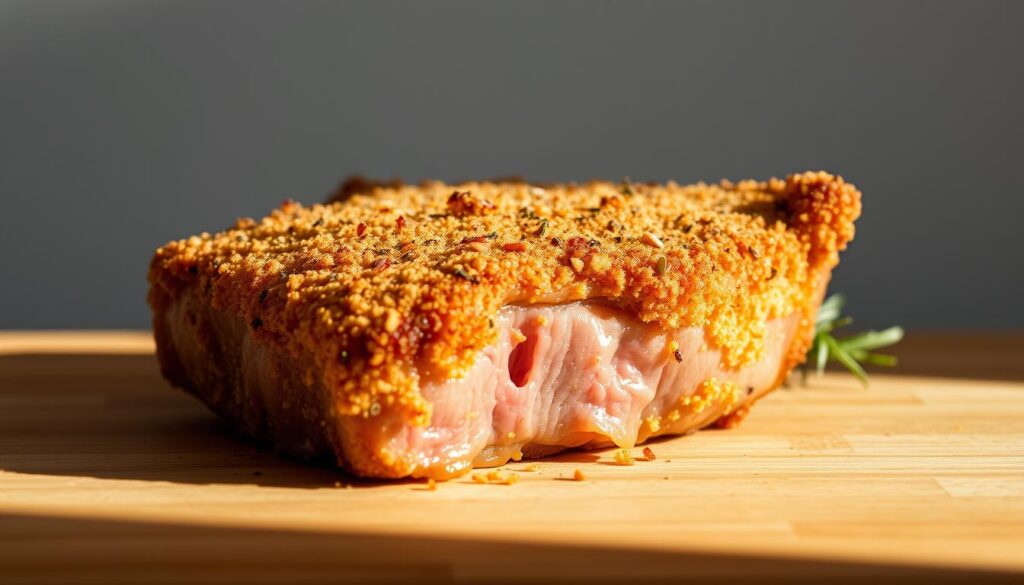
Learning how to bread fried deer meat can make your venison truly special. The right breading technique makes your deer steak crispy and flavorful. It also gives it a golden-brown look that’s hard to resist.
To get the perfect breading, start by drying your venison with paper towels. This step is key to getting a crispy finish. It helps the breading stick better to the meat.
- Choose a multi-layer breading approach for maximum crunch
- Use corn flake crumbs for an extra crispy texture
- Season your breading mixture generously
Your breading station needs three main parts:
- Flour seasoned with salt and pepper
- Beaten eggs with a splash of buttermilk
- Final coating of seasoned breadcrumbs or corn flake crumbs
When preparing fried deer meat, keep these seasoning tips in mind:
| Seasoning | Quantity | Purpose |
|---|---|---|
| Garlic Powder | 1 tsp | Adds depth of flavor |
| Onion Powder | 1 tsp | Enhances savory notes |
| Cayenne Pepper | ½ tsp | Provides subtle heat |
For the crispiest deer steak, let your breaded venison rest for 10-15 minutes before frying. This helps the breading stick better. Heat your oil to 350-375°F for a golden-brown crust that will make your fried deer meat irresistible.
Serving Suggestions and Side Dishes
When you’re cooking southern dishes with venison, picking the right sides can make your meal amazing. Your fried deer meat needs sides that match its rich taste. This will make your meal even better.
Classic Southern Accompaniments
Traditional southern sides go great with fried venison. Here are some classic choices that add comfort and authenticity:
- Creamy buttermilk mashed potatoes
- Crispy cornbread with honey butter
- Slow-cooked collard greens
- Savory country gravy
- Black-eyed peas
Modern Pairing Ideas
If you’re looking for new venison dishes, try these modern side dish ideas. They add a fun twist to your meal:
- Roasted root vegetable medley
- Quinoa salad with fresh herbs
- Grilled asparagus with lemon zest
- Wild rice pilaf
- Citrus-infused mixed green salad
The secret to a great southern meal is balancing flavors and textures. Your fried venison should be the main event. The sides should enhance and complement it.
Common Cooking Mistakes to Avoid
Preparing fried deer meat needs precision and skill. Many home cooks make mistakes that ruin a dish. Knowing these errors can help you make delicious venison dishes.
One big challenge is keeping the cooking temperature right. Overcooking venison makes it dry and tough. Cook it quickly at high heat to keep it juicy.
“Precision is the secret to transforming wild game from good to extraordinary.” – Hunting & Cooking Experts
- Avoid cooking venison beyond medium-rare (130-140°F internal temperature)
- Use a meat thermometer to ensure accurate cooking
- Rest meat for 10-15 minutes after cooking to redistribute juices
- Select the right cut for frying (backstrap or tender cuts work best)
Marination is key in preparing wild game recipes. Deer meat can taste gamey, so you need to season it right. Marinating for 2-4 hours tenderizes the meat and adds flavor. Chefs say acidic ingredients like vinegar or citrus help.
Another mistake is using the wrong oil temperature for frying. Oil that’s too cool makes meat greasy, while too hot burns it. Keep the oil between 350-375°F for the best fried deer meat.
Pro Tip: Always pat your venison dry before frying to achieve a crispy, golden-brown exterior.
Storage and Handling Guidelines
Keeping your hunting recipes and venison dishes fresh is key. Hunters and cooks need to know how to store deer meat right. This ensures your dishes taste great and are safe to eat.

Proper Freezing Methods
Freezing venison needs careful steps to avoid freezer burn and keep the meat quality high. Here are the must-follow tips for storing your deer meat:
- Wrap venison tightly in freezer paper or vacuum-sealed bags
- Remove as much air as possible to prevent freezer burn
- Label packages with the date and cut of meat
- Store at 0°F or lower for optimal preservation
“Proper freezing is the key to preserving the rich flavor of your wild game meat.”
Thawing Recommendations
Thawing your venison safely is important to keep its quality. Here are the best ways to thaw:
- Refrigerator thawing: Move meat from freezer to refrigerator 24-48 hours before cooking
- Cold water thawing: Submerge sealed package in cold water, changing water every 30 minutes
- Avoid room temperature thawing to prevent bacterial growth
Pro tip: Frozen venison can be safely stored for up to 12 months when properly packaged. Always check the meat for freezer burn or color changes before cooking your favorite dishes.
Venison is leaner than other meats. So, it’s even more important to store it right. This helps keep its special flavor and nutritional benefits.
Health Benefits of Cooking with Venison
Venison dishes are a nutritional powerhouse compared to regular meats. Deer meat in wild game recipes is a rich source of health benefits. It’s perfect for those looking for a protein that’s full of nutrients.
The nutritional benefits of venison are impressive. A 100-gram serving offers:
- High protein content: 21.8g per 100g (raw)
- Low calories: Only 157 kcal per 100g
- Minimal saturated fat: 3.4g per 100g
Choosing venison over other meats can greatly enhance your diet. It has nearly twice the B vitamins of beef. This supports nerve function and hormone balance.
| Nutrient | Venison Value | Beef Comparison |
|---|---|---|
| Omega-3 Content | 104 mg | 5x Lower |
| Zinc (% RDI) | 28-35% | Lower |
| Vitamin B12 | 31-39% RDI | Lower |
Wild game recipes with venison are great for heart health. The meat’s omega-3 to omega-6 ratio helps lower inflammation. This supports a healthy heart.
Adding venison dishes to your meals is a smart choice. It’s not only tasty but also full of important nutrients. Unlike other meats, venison is free from hormones and antibiotics. It’s a cleaner, more natural option for those who care about their health.
Wild Game Cooking Safety Tips
When you’re cooking up hunting recipes, safety is key. Knowing how to handle meat right can stop foodborne illnesses and make sure your dishes are tasty.
Keeping an eye on the temperature is vital when cooking wild game. For venison, it should be cooked to 135°F. This kills off bad bacteria and keeps the meat good. Always use a meat thermometer to check if it’s done.
- Clean all cooking equipment thoroughly before and after use
- Keep raw meat separate from other food items
- Wash hands frequently during meat preparation
- Refrigerate game meat promptly after harvesting
Field dressing and handling the meat right are key to safety. Rapid cooling of the carcass stops bacteria from growing. Try to cool the meat to 34°F to 37°F within a few hours. This keeps the meat fresh and cuts down on contamination risks.
For outdoor cooking, remember these safety tips:
- Always use clean cutting surfaces
- Store game meat at proper refrigeration temperatures
- Avoid cross-contamination during preparation
- Cook meat to recommended internal temperatures
When aging venison, temperature control is crucial. Meat should be aged at 34°F to 37°F for 10 to 14 days. This makes the meat tender while keeping it safe for your recipes.
Conclusion
Your journey into wild game recipes has shown you the amazing side of fried deer meat. You’ve learned how to cook venison, making it more than just a meal. It’s a delicious adventure.
For the best fried deer meat, it’s all about understanding its lean nature. You’ve learned how to pick the right cuts and how to fry them perfectly. Now, you can make a dish that will wow everyone.
As you keep trying new things, remember that cooking venison is both an art and a science. Every time you make fried deer meat, you get better. You’ll love the unique tastes that wild game offers.
Your adventure with venison is just starting. Whether you’re a seasoned hunter or a curious cook, there’s so much to explore. Keep learning, keep cooking, and enjoy every bite.
FAQ
What makes venison different from other meats?
Venison is lean and comes from wild deer. It has less fat than beef or pork. This makes it high in protein and has a unique taste.
Its flavor reflects the deer’s wild habitat. This sets it apart from other meats. It’s also very nutritious.
How do I prevent deer meat from tasting too gamey?
To reduce gamey flavors, trim excess fat and silverskin. Marinate the meat in acidic ingredients like vinegar or citrus. Soak in milk or buttermilk before cooking.
Use proper aging and cleaning techniques. Selecting fresh meat and using the right seasoning can also help.
What are the best cuts of venison for frying?
Tender cuts like loin and tenderloin are great for quick frying. Tougher cuts such as shoulder or leg can be pounded thin or sliced against the grain. Choose thin cuts for crispy fried dishes.
How long should I cook fried deer meat?
Cooking time depends on the cut’s thickness. Venison should be cooked quickly at medium-high heat. Thin cutlets take 2-3 minutes per side.
Thicker steaks might need 4-5 minutes. Avoid overcooking to keep it lean and tender.
Is venison a healthy meat option?
Yes, venison is very healthy. It’s high in protein and low in fat. It’s also rich in iron and B vitamins.
Wild game like venison has fewer additives. It’s a lean meat option that’s good for you.
What are some traditional ways to season fried deer meat?
Southern cooking uses black pepper, garlic powder, and paprika. Classic marinades include buttermilk, herbs, and apple cider vinegar. Cajun and creole spice blends also work well.
How do I store leftover fried deer meat?
Store it in an airtight container in the fridge for 3-4 days. Freeze for up to 3 months for longer storage. Reheat in an oven or air fryer to stay crispy.
Avoid microwave heating to prevent toughness and sogginess.
What side dishes pair well with fried deer meat?
Classic sides like collard greens, cornbread, and mashed potatoes are great. Modern options include roasted vegetables, quinoa salads, or grain-based sides. A light, acidic sauce can balance the rich flavor.
Source Links
- Easy Pan Seared Deer Kidneys with Apple Cider Sauce – https://wildgameandfish.com/deer-kidneys/
- Michigan-Style Fried Deer Heart Recipe – https://www.themeateater.com/cook/recipes/michigan-style-fried-that-is-hunters-heart-recipe
- Deer Bologna Is The Unique Meat That Belongs On Your Next Charcuterie Board – https://www.yahoo.com/lifestyle/deer-bologna-unique-meat-belongs-104000323.html
- Exploring Wild Game Flavors, From Venison to Bison – Y.O. Ranch Steakhouse – https://www.yoranchsteakhouse.com/blog/exploring-wild-game-flavors-from-venison-to-bison/
- Deer Anatomy: Venison Cuts and How to Use Them – https://huntwise.com/field-guide/deer/deer-anatomy-venison-cuts-and-how-to-use-them
- The Best Country Fried Steak (Venison Cube Steak Recipe) – https://wildgameandfish.com/country-fried-deer-steak/
- How to Cook a Juicy Venison Steak | Marinated Deer Steak – https://www.missallieskitchen.com/venison-steak/
- Pan fried Venison Steak Recipe – https://foodmeanderings.com/pan-fried-venison-steak-recipe/
- The Best Venison Backstrap Recipes – https://www.outdoorlife.com/hunting/venison-backstrap-recipes/
- Delicious Venison Backstrap Recipes – https://atastykitchen.com/delicious-venison-backstrap-recipes/
- The Best Deer Heart Recipes – https://www.outdoorlife.com/hunting/deer-heart-recipes/
- Amazing Country Fried Venison: A Gourmet Delight From The Wild – https://kowalskimountain.com/country-fried-venison/
- Fried Venison Cutlets – https://www.foxvalleyfoodie.com/fried-venison-cutlets/
- Fried Venison Cube Steak with Cream Gravy – https://mytxkitchen.com/fried-venison-cube-steak/
- Easy Deer Steak Frites (Steak and Fries) Recipe – https://wildgameandfish.com/deer-steak-frites-recipe/
- 20+ Venison Steak Recipes | Peak to Plate – https://peaktoplate.com/venison-steak-recipes/
- Chicken Fried Venison – https://www.binkysculinarycarnival.com/chicken-fried-venison/
- Venison cube steak recipes:Delicious Chicken Fried You’ll Love 2025 – https://www.mealtrek.com/venison-cube-steak-recipes/
- The Best Venison Steak with Oregano | Easy Recipe – The Home Intent – https://thehomeintent.com/venison-steak-with-oregano/
- Country Fried Venison and Gravy – https://www.moultrie.com/blog/country-fried-venison-and-gravy-/
- 50 Kitchen Mistakes You’re Probably Making—And How to Fix Them – https://www.rd.com/list/stupid-kitchen-mistakes/
- The Easiest And Most Delicious Venison Backstrap Recipe – Miss Allie’s Kitchen – https://www.missallieskitchen.com/venison-backstrap-recipe/
- venison cube steak recipes: 7 Unbelievable Tips – https://www.bradyrecipes.com/venison-cube-steak-recipes/
- How to Cook Venison – https://www.outdoorlife.com/hunting/how-to-cook-venison/
- What Are the Health Benefits of Deer Meat? – https://www.webmd.com/diet/health-benefits-deer-meat
- Venison vs Beef: Which Is Healthier? – https://hunter-ed.com/blog/venison-vs-beef-which-is-healthier/
- 9 Health Benefits of Venison Meat (and Full Nutrition Facts) – https://www.nutritionadvance.com/venison-meat-nutrition-benefits/
- What Are the Health Benefits of Elk Meat? – https://www.webmd.com/diet/health-benefits-of-elk-meat
- Wild Side of the Menu No. 1 Care and Cookery – https://www.ndsu.edu/agriculture/extension/publications/wild-side-menu-no-1-care-and-cookery
- Minimum Temperatures for Cooking Wild Game Meat – https://www.bowhunting.com/article/minimum-temperatures-for-cooking-wild-game-meat/
- Venison Jalapeño and Cheese Summer Sausage: A ‘s Delight – – https://butcherbbq.com/blogs/news/venison-jalapeno-and-cheese-summer-sausage-a-butchers-delight?srsltid=AfmBOooiHAnAfYh6AHjsiLxoenNhlSR2F3uT4GlCIQFrRCSCL21dTRzL
- Venison Processing Equipment: Essential Tools for Efficient Meat Processing – ArticleTed – News and Articles – https://www.articleted.com/article/921955/53967/Venison-Processing-Equipment–Essential-Tools-for-Efficient-Meat-Processing
